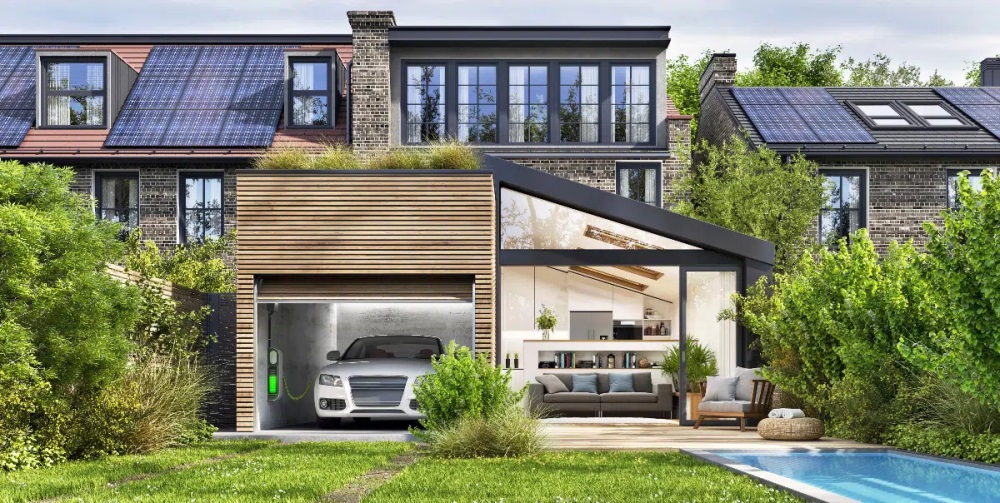What Is Whole Home Electrification?

4 Min. Read
The shift from fossil fuels toward renewable energy sources has accelerated the home electrification movement. As a result, many homeowners are converting their homes to go fully electric, saving money and the environment in the process. Here’s what you should know about electrification and what it could mean for your home.
What is home electrification?
The broad definition of electrification is simply to change a process, function or location to electric power. On a regional level, it could mean a city decides to provide electricity to rural residents. Here we will be talking about home electrification. Through this process, you move all of your home’s functions to electricity rather than natural gas, oil or wood.
Home electrification is not a new phenomenon; it has been increasing for decades without much public policy to encourage the process. According to a paper from UC Berkeley, home electrification went from just 1% to nearly 40% in the years from 1950 to 2018. The increase evolved naturally as electrically powered products and devices became smaller and more efficient. Today, estimates say that at least 25% of all homes in the United States are entirely electric.
Home electrification offers dozens of benefits. For example, you can see obvious energy savings reflected in your bank account each month. However, there are also environmental benefits that may not be immediately apparent.
Lower monthly energy costs with whole home electrification
Switching to electric appliances saves you money over the lifetime of your home. A new construction electrified home saves on average $130 to $540 annually over legacy homes, but this is a national statistic. Many areas see more significant savings due to the cost of natural gas in those regions. As the reliability and capacity of electric power grids continue to improve, these savings will increase.
Fully electric HVAC, water heaters and stoves have helped spur the move to building electrification. Because these high-draw items can be a significant portion of monthly energy bills, electrifying them makes sense. Around 25% of total energy use goes to heating the home while 10% goes to water heating. Switching to a heat pump water heater can save an average of $330 per year, while an all-electric HVAC system can reduce energy costs by $1,000 annually.
Environmental benefits
Home electrification also reduces indoor pollutants such as carbon monoxide, nitrogen dioxide and particulates. For example, homes that use gas stoves can have up to 400% higher nitrogen dioxide levels than those with electric stoves. As a result, occupants of homes that use gas stoves are at risk for lung irritation, asthma and other respiratory ailments. By eliminating this source of pollution, electrified homes provide a cleaner, safer environment for everyone inside.
The outside environment also benefits from home electrification. For instance, electrified homes emit far less pollution than homes powered by natural gas. This difference equates to a much smaller, and in some cases, net-zero impact on the ecosystem.
Home electrification costs – electric panels and more
The process of home electrification is not as challenging as you may think. The biggest hurdle for most homeowners is cost. New homes may only incur a couple of thousand dollars in additional cost to build fully electric. However, retrofitting existing homes can be far more expensive. A study by the city of San Francisco estimates that full electrification retrofits would cost between $14,363 and $34,790. A big part of this expense is the need to open up walls to upgrade wiring, the cost of the wiring itself and the labor involved. Obviously, the bigger the home, the higher the cost.
The new electrified appliances will also require more robust electrical service. If you do not have at least 100 amps available, you will most likely have to upgrade. New panel installations can run between $1,100 and $2,500. You will need a certified electrician to handle the upgrade; it is dangerous to mess with high current circuits and breakers without extensive knowledge of electricity.
For all of these reasons, planning ahead is critical. First, use an online checklist or consult with contractors and installers to get an idea of what your home will require. Then, consider making gradual changes as the need arises instead of attempting to switch all of your energy use in one fell swoop. This planning will allow you to control the budget far better.
Qmerit is your home electrification partner
Upgrading your home to partial or full electrification is complicated. It’s not a do-it-yourself project; you’ll need a partner to help you through the process. Visit our Electrification Institute to learn more.
As the leading installer of electrification technologies, Qmerit provides the expertise and experience you can trust in the rapidly evolving world of electrification. With the largest and most qualified network of certified electricians in North America, we’ve installed more than 269,000 EV charging stations, 18,500 battery storage energy systems, 53,000 solar panel system integrations, and 86,700 electric panel upgrades.
Join us in our mission to transform our planet to a more sustainable, energy-resilient, electric-powered future. Give us a call at (888) 272-0090 or request a consultation and our Customer Success Team will contact you.
